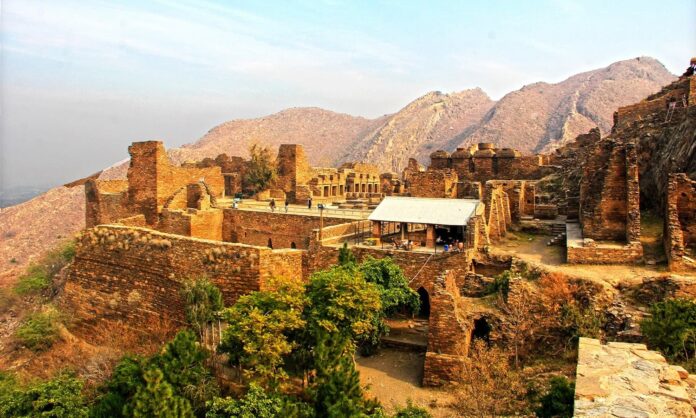PESHAWAR: Malaika Bibi, an 10-year-old girl student was overjoyed after visiting the world lone Ghandhara Art Peshawar Museum where about 30,000 rare antiquities and artifacts including the complete life story of Lord Buddha, the founder of Buddhism, were kept preserved.
Arrived with his father from the Nowshera district to the Peshawar Museum located on Sher Shah Suri Road in the cantonment, the archaeology lover along with family members took a keen interest in the ancient antiquities and artifacts of the Gandhara civilization, weapons of British army and swords of the freedom fighters displayed there.
“Today my dream to see all the Ghandhara masterpieces practically at Peshawar Museum came true. I am very impressed after seeing/hearing about the complete life story of Lord Buddha,” she told APP after making a selfie with Lord Buddha’s statute with a big smile.
Peshawar Museum was constructed some 150 years back where over 30,000 rare antiques, artifacts, coins, swords, guns and other antiquities including 16,000 properly showcased and around 14,000 artifacts were lying in cupboards, attracting tourists from across the world.
Malaika along with her father and brothers were overwhelmed after seeing the ancient dresses of Waziristan tribes, primitive cooking plates and jewelry besides muzzleloader guns mostly used by British army, swords of freedom fighters and punch marked coins.
They went around the two-storey building, an amalgamation of British and Mughal architectures, which was originally consisted of a main hall and two side aisles on ground and first floor, surmounted by four elegant cupolas and small pinnacle on all corners and commended the rehabilitation and conserved works of KP government.
“Peshawar Museum was the identity of Peshawar and its proper projection through digital and social media can bring economic luruls for the country,” she said.
“It is the only Museum in the world where the complete life story of the Founder of Buddhism, Lord Bhudda was preserved in the form of panels and statues,” said Bakht Zada Khan, research officer, the archaeology and museums department while talking to APP.
He said its main hall constructed in 1906 in memory of Queen Victoria where the complete life story of Lord Bhudda, Buddha Gallery with statues of Lord Bhudda and Buddha Savatta Gallery has princely life of Lord Bhudda draw domestic and foreign tourists in droves.
Bakht Zada said the museums’ antiquities help archaeologists to explore the Khyber Pakhtunkhwa history in its authentic perspective.
“The Sangaro cave’s excavations Mian Khan, Mardan conducted by the renowned archeologist Ahmad Hasan Dhani and Farid Khan in 1963 had revealed the presence of people’s remains in the Middle Paleolithic period (9,000 to 27,000) years before present in KP.’
He said these people were living in stone-made caves, who fulfilled their food mostly from hunting of birds and animals. The discoveries of primitive rocks, bones and hunting tools dating back of Mesolithic or Middle Stone Age (10,000 to 8,600 years before present) during excavations at Khanpur in Haripur district and Sangaro Cave signified presence of humans’ life in Swat and Dir where every stone speaks.
He said people started making clay and stones made pots, crockery and others related utensils for kitchen during the Neolithic period or commonly known as new stone-age dating back some 8,000 years before as evident from excavations of historic Mehar Gharh in Balochistan of the Indus Civilization, Rehman Dheri DI Khan and Sheri Khan Tarkai Swabi.
“The graves of Aryans invaders were also discovered at Aligram Swat, Sangota Chitral and Timergara Dir Lower dating back to the Dark Ages period of around 2,000 BC.”
The Gandhara civilization has gained roots in the province after Persians conquered it in 6th century BC and made it one of the provinces of the Achaemenid Empire, he said.
He said reading and writing in Swat, Dir, Mardan, Charsadda, Peshawar and Malakand, famous for Ghandara civilization, were started as evidence of the inscriptions mostly made on stones by Iranians. In 327 BC, Alexander the Great invaded the subcontinent through Khyber Pass and faced tough resistance while trying to subdue Youafzai tribesmen at Swat and Kunar valleys.
Bakht Zada said the international magazine “Archaeology”, a publication of the Archaeological Institute of America has issued a list of the top 10 best archaeological discoveries of the world including the Buddhist Apsidal temple at Bazira Barikot in Swat in 2022.
A museum was constructed near historical site at Hund Swabi from where Alexander the Great had crossed Indus River in 327 BC. Hund is also famous for Mehmood Ghaznavi’s invasion in 998, which marked beginning of Islamic era in the region.
He said the construction of two new museums in DI Khan and Abbottabad were almost completed where ancient antiquities depicting the area’s culture would be put on display besides two more museums in Kohat and Haripur were in pipeline.
Following the completion of these four new museums, the number of museums would increase to 16 in KP where 10 new museums were already established including three in Peshawar, one each at Charsadda, Mardan, Lower Dir, Swat, Bannu and two in Chitral.
Cultural Heritage Trail project had been completed in Peshawar under which about 500 meters long trail from ancient Ghanta Ghar to Gor Gathri was renovated including 85 centuries-old buildings and houses besides architectural wonder Sethi House constructed in 1880.
About 1868 ancient houses, monuments and religious places were placed on the protected list including Amlokdara, Barikot, Stupa in Saidu Sharif, Bhudkada, Godara and Panar in Swat besides a monument at Chacha Younas Park in Peshawar.
The experts underscored the need for proper projection of these archaeological wonders of Pakistan through social and digital media besides special documentaries to attract foreign investment.





















